Daylilies
BackDaylilies (Hemerocallis spp) are an easy to grow perennial that are adored for their beautiful lily-like flowers. These flowers come in all colours, except true blue, with the common varieties producing flowers in warm shades of yellow, red and apricot. Specialist growers also offer varieties with blooms in cooler hues as well some with fancy ruffled petals and others with coloured ‘eyes’ at the base of the bloom.
Daylilies get their common name because the flowers last for just one day. Don’t be put off by this as an established plant will produce multiple blooms on each stem so the flowering actually extends over a long period. Plants will also produce 2-4 flushes of flowers from spring to autumn (depending on the variety). The flowers are edible and taste a bit like zucchini flowers. Use them to brighten up a salad or decorate a cake. The buds are also edible with a slight peppery taste and can be steamed, stir fried or boiled.
How to Grow Daylilies
Daylilies make great feature plants for cottage gardens and perennial borders with them ranging in size from around 50cm to 1m tall. Most are evergreen but some turn semi-evergreen during winter. In addition there are dwarf forms that grow 30cm to 50cm tall and are perfect for pots.
Daylilies are suited to a wide range of climates and grow easily over most of Australia including humid coastal zones and frosty locations. The one exception being tropical areas that lack cooler days or nights in winter. They need at least five to seven hours of sun a day to bloom well but prefer some afternoon shade in very hot arid regions. They also need free draining soils.
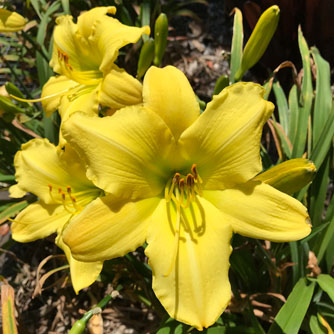
The irresistible glow of daylily blooms!
Plants are bought as either potted plants or bare-rooted rhizomes and should be planted into soil that has been improved with compost or animal manures. Sandy soils will also benefit from the addition of clay and an application of OCP eco-hydrate. Position plants approximately 60-90cm apart (closer for dwarf forms). To plant bare-rooted rhizomes dig a hole, form a mound in the base of the hole, then spread the roots over it and backfill with soil. The crown, which is where the roots meet the stem, should be 2cm below the surface. Potted plants should be planted so the potting mix is at the same level as the soil. Water plants in with OCP eco-seaweed and keep well mulched.
Daylilies will cope with poor soil and limited water but will have the most prolific flowering in fertile, moist conditions. It’s why we recommend improving the soil before planting.
To encourage strong growth and lots of flowers apply OCP eco-seaweed and OCP eco-aminogro every 2-4 weeks (especially young plants which are establishing). In early spring and autumn give plants some organic fertiliser pellets and top up the compost/manure particularly if your soils are on the poor side.
Maintenance, Pruning and Dividing of Daylilies
To keep plants looking tidy and encourage further blooms regularly move spent flower spikes.
As the older outer leaves die off they can be left to slowly drop and ‘self mulch’ around the base of the plant. If however you prefer a tidier look then these can be manually removed a few times a year instead. Note that leaf death increases when plants are grown with minimal water.
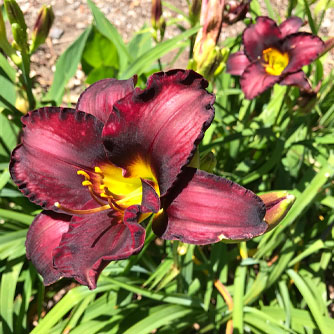
Many of the dark coloured daylilies have a velvety look to their petals
Over time daylilies develop into clumps which can be dug up and divided into smaller plants using a spade or secateurs. Make sure each new section has a rhizome and a few leaves. Cut back the foliage to just 10cm long before replanting each division into improved soil. Water in with OCP eco-seaweed.
New plants also appear on the ends of the flower spikes in some varieties. These can be cut off with sharp secateurs once they’re about 10cm big and replanted.
Pests and Diseases of Daylilies
Plants are generally trouble free but watch out for these pests:
- Aphids – they mostly only appear in early spring on new growth and can easily be controlled with a spray of OCP eco-oil or OCP eco-neem.
- Snails and slugs – can badly disfigure the foliage especially young plants. Apply OCP eco-shield pellets as required.
- Rust – this fungal disease tends to be more of a problem in humid conditions and only on some varieties. Use regular applications of OCP eco-seaweed and OCP eco-aminogro to build a stronger plant with more disease resistance. If necessary spray with an organic fungicide or try growing a different variety.

Double forms are not seen as often but certainly worth hunting down
Daylily Varieties
There are fifteen daylily species native to East Asia but plants sold in Australia are almost exclusively hybrids. In fact there are hundreds of named hybrid varieties available which range from flowers which are singles, doubles or ‘spider’ forms (they have narrow curled petals). A small number even have some perfume.
A limited selection of potted plants are sold through general nurseries, usually when plants are in flower but for the most choice you’ll need to order bare-rooted rhizomes online from specialist daylily nurseries.
While everyone has different favourites these are some which are popular amongst out team:
- ‘Stella Bella’ – One of the very best as its golden-yellow flowers come in flushes for up to six months of the year. It has been used extensively in breeding. 40cm x 40cm.
- ‘Stella D’Oro’ – An excellent, long flowering form with golden yellow blooms. 30-45cm x 55cm.
- ‘Stella Rouge’ – Bred from ‘Stella Bella’ this daylily has bright red flowers with a yellow centre. 40cm x 40cm.
- ‘Rapid Eye Movement’ – Large amber-gold flowers (up to 17cm wide) with a dramatic plum coloured eye. 30cm x 70cm.
- ‘On and On’ – Prolific repeat flowering with apricot-pink fragrant blooms. 40cm x 50cm.
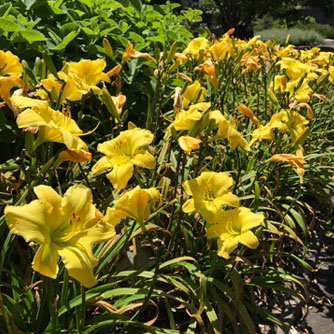
Daylilies look fantastic when mass planted
- ‘Cranberry Baby’ – A dwarf form with crimson-pink single flowers. 30cm x 30cm.
- ‘Maleny Sensation’ – A full double flower up to 15cm wide with ruffled claret-coloured petals and a chartreuse throat. 50-60cm x 50-60cm.
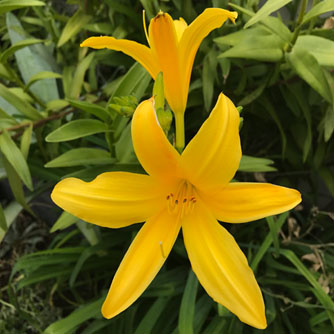
Even the simple old-fashioned daylily varieties are stunning
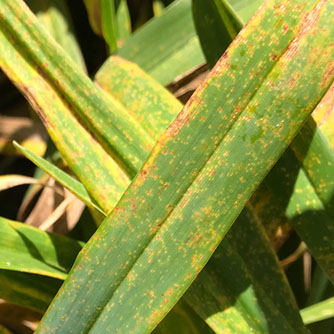
Leaves with yellow and orange markings are being attacked by the rust fungus


